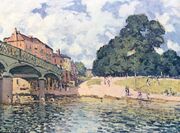| BRIDGE | ||

| ||
| Carries | - | |
| Maintained by | - | |
| Design | Arch Bridge | |
| Total Length | - | |
| Clearance Below | - | |
| Opening Date | 3 July 1933 | |

Alfred Sisley's painting of the third iron bridge
Hampton Court Bridge crosses the River Thames in England in a north to south direction between East Molesey, Surrey and Hampton Court Palace, Greater London. It is on the reach above Teddington Lock and about hundred yards upstream of the bridge is Molesey Lock.
On the north bank is Hampton Court Palace, Hampton Court Park and Bushy Park. On the south bank is Hampton Court Station, Molesey Lock and the mouth of the River Mole.
Historic crossings

Engraving by Charles Grignion (after A. Heckel) of the 1753 bridge
The location of the bridge had been a ferry crossing point since at least the Tudor period. The first bridge was built 1752–53, after a 1750 parliamentary bill enabled the construction of a privately owned bridge by James Clarke. It had seven wooden arches, and was built in the Chinoiserie design of the Willow pattern that was popular at the time.
It was subsequently replaced by a more sturdy wooden bridge in 1778. In 1840 this bridge had become dilapidated and the owner appealed to the City of London Corporation to support reconstruction. Among their arguments were that since the bridge was built, the City had created Molesey Lock and Weir and as a consequence navigation through the bridge was dangerous. The bridge was described about this time as "crazy, hog-backed, inconvenient and obstructive of the navigation".
In 1864–66, a new bridge was built, designed by E. T. Murray. It consisted of wrought iron lattice girders resting on four cast iron columns. The approach was between battlemented brick walls. One of these approach walls still remain on the south bank.
The Modern Bridge
The modern bridge is the fourth to be located on the site. It was designed by W. P. Robinson and Sir Edwin Lutyens to reflect the style of portions of Hampton Court Palace designed by Sir Christopher Wren. The bridge has 3 arches, and is designed to carry road traffic.
Construction of the present bridge began in 1930. The work included demolition of a hotel (the Old Castle), diverting the flow of the River Mole into the River Ember, and constructing a new road. Today this road is known as Hampton Court Way and connects the A308 with the A307 (Portsmouth road). The bridge is constructed of reinforced concrete and faced with red bricks.
The bridge was opened by Edward VIII, then Prince of Wales on 3 July 1933 on the same day as the opening of Chiswick Bridge and Twickenham Bridge, which carry the A316 (the stretch then called the Richmond bypass).
| This page uses Creative Commons Licensed content from Wikipedia (view authors). That Wikipedia page probably contains more information. |